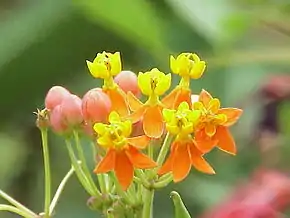Asclepiadaceae
La famille des Asclepiadaceae regroupe 2 000 espèces de plantes dicotylédones réparties en près de 250 genres. Cette famille n'est plus valide dans la classification phylogénétique. Elle est maintenant considérée au sein de la famille des Apocynaceae comme la sous-famille des Asclepiadoideae.

| Règne | Plantae |
|---|---|
| Sous-règne | Tracheobionta |
| Division | Magnoliophyta |
| Classe | Magnoliopsida |
| Sous-classe | Asteridae |
| Ordre | Gentianales |
Il s'agit d'une famille cosmopolite composée en majorité de plantes herbacées, de lianes, d'arbustes, mais aussi quelques arbres, parfois à l'aspect cactoïde. On trouve ces espèces dans les régions subtropicales à tropicales, avec quelques rares espèces en régions tempérées.
En France, on peut citer les genres :
- Vincetoxicum avec le dompte-venin officinal (Vincetoxicum hirundinaria), plante très toxique, et
- Cynanchum.
Étymologie
Le nom vient du genre type Asclepias, que Carl von Linné nomma d’après Asclépios (du grec Ἀσκληπιός / Asklêpiós, en latin Aesculapius / Esculape), dieu grec de la médecine, cette plante possédant de nombreuses vertus en phytothérapie.
Classification
La classification phylogénétique APG (1998)[1], la classification phylogénétique APG II (2003)[2] et la classification phylogénétique APG III (2009)[3] incorporent cette famille aux Apocynaceae, sous-famille Asclepiadoideae.
Liste des genres
- Absolmsia
- Adelostemma
- Aidomene
- Amblyopetalum
- Amblystigma
- Ampelamus Pfeiffer
- Anatropanthus
- Anisopus
- Anisotoma
- Anomotassa
- Araujia Brot.
- Asclepias L.
- Aspidoglossum
- Astephanus
- Barjonia
- Belostemma
- Bidaria
- Biondia
- Blepharodon
- Blyttia
- Brachystelma
- Calotropis R.Br.
- Campestigma
- Caralluma
- Ceropegia
- Cibirhiza
- Cionura
- Clemensiella
- Conomitra
- Cordylogyne
- Corollonema
- Cosmostigma
- Costantina
- Cyathostelma
- Cryptostegia R.Br.
- Cynanchum L.
- Dactylostelma
- Dalzielia
- Decabelone
- Decanema
- Decanemopsis
- Dicarpophora
- Diplolepis
- Diplostigma
- Dischidanthus
- Dischidia
- Ditassa
- Dittoceras
- Dolichopetalum
- Dolichostegia
- Dorystephania
- Dregea
- Drepanostemma
- Duvalia
- Duvaliandra
- Echidnopsis
- Edithcolea
- Emicocarpus
- Emplectranthus
- Eustegia
- Fanninia
- Fischeria
- Fockea
- Folotsia
- Frerea
- Funastrum Fourn.
- Genianthus
- Glossonema
- Glossostelma
- Gomphocarpus
- Gongronema
- Gonioanthelma
- Goniostemma
- Gonolobus Michx.
- Graphistemma
- Gunnessia
- Gymnema R.Br.
- Gymnemopsis
- Harmandiella
- Hemipogon
- Heterostemma
- Heynella
- Hickenia
- Holostemma
- Hoodia
- ×Hoodiopsis
- Hoya R.Br.
- Hoyella
- Huernia
- Huerniopsis
- Hypolobus
- Ischnostemma
- Jacaima
- Janakia
- Jobinia
- Kanahia
- Karimbolea
- Kerbera
- Labidostelma
- Lachnostoma
- Tenaris
- Lavrania
- Leichardtia
- Leptadenia
- Lhotzkyella
- Lugonia
- Lygisma
- Macroditassa
- Macropetalum
- Macroscepis
- Mahafalia
- Mahawoa
- Manothrix
- Margaretta
- Marsdenia R.Br.
- Matelea Aubl.
- Melinia
- Mellichampia
- Meresaldia
- Merrillanthus
- Metaplexis R.Br.
- Metastelma R.Br.
- Micholitzea
- Microdactylon
- Microloma
- Microstelma
- Miraglossum
- Mitostigma
- Morrenia Lindl.
- Nautonia
- Nematostemma
- Neoschumannia
- Nephradenia
- Notechidnopsis
- Odontanthera
- Odontostelma
- Odontostephana
- Oncinema
- Oncostemma
- Ophionella
- Orbea
- Orbeanthus
- Orbeopsis
- Oreosparte
- Orthanthera
- Orthosia
- Oxypetalum R.Br.
- Pachycarpus
- Pachycymbium
- Papuastelma
- Parapodium
- Pectinaria
- Pentabothra
- Pentacyphus
- Pentarrhinum
- Pentasachme
- Pentastelma
- Pentatropis
- Peplonia
- Pergularia L.
- Periglossum
- Periploca L.
- Petalostelma
- Petopentia
- Pherotrichis
- Piaranthus
- Platykeleba
- Pleurostelma
- Podandra
- Podostelma
- Prosopostelma
- Pseudolithos
- Ptycanthera
- Pycnoneurum
- Pycnorhachis
- Quaqua
- Quisumbingia
- Raphistemma
- Rhyncharrhena
- Rhynchostigma
- Rhyssolobium
- Rhyssostelma
- Rhytidocaulon
- Riocreuxia
- Rojasia
- Rothrockia
- Sarcolobus
- Sarcostemma R.Br.
- Schistogyne
- Schistonema
- Schizoglossum
- Schubertia
- Scyphostelma
- Secamone
- Secamonopsis
- Seshagiria
- Sisyranthus
- Solenostemma
- Sphaerocodon
- Spirella
- Stapelia L.
- Stapelianthus
- Stapeliopsis
- Stathmostelma
- Steleostemma
- Stelmagonum
- Stelmatocodon
- Stenomeria
- Stenostelma
- Stigmatorhynchus
- Strobopetalum
- Stuckertia
- Swynnertonia
- Tassadia
- Tavaresia
- Telminostelma
- Telosma Cov.
- Tenaris
- Tetracustelma
- Tetraphysa
- Thozetia
- Toxocarpus
- Treutlera
- Trichocaulon
- Trichosacme
- Trichosandra
- Tridentea
- Tromotriche
- Tweedia
- Tylophora
- Tylophoropsis
- Vailia
- Vincetoxicopsis
- Vincetoxicum
- Voharanga
- Vohemaria
- White-sloanea
- Widgrenia
- Woodia
- Xysmalobium.
Liens externes
- Flore photographique régionale
- La famille des Asclepiadaceae
- (en) Référence DELTA Angio : Asclepiadaceae
- (en) Référence Flora of China : Asclepiadaceae
- (en) Référence Madagascar Catalogue : Asclepiadaceae
- (en) Référence Flora of Chile : Asclepiadaceae
- (en) Référence Jardin botanique du Missouri : Asclepiadaceae (images de Madagascar)
- (en) Référence FloraBase (Australie-Occidentale) : classification Asclepiadaceae
- (en) Référence DELTA Angio : Asclepiadaceae
- (fr+en) Référence ITIS : Asclepiadaceae Non valide
- (fr+en) Référence ITIS : Apocynaceae
- (en) Référence NCBI : Apocynaceae (taxons inclus)
- (en) Référence GRIN : famille Asclepiadaceae Borkh. (+liste des genres contenant des synonymes)
- Portail de la botanique
- (en) Angiosperm Phylogeny Group, « An ordinal classification for the families of flowering plants », Annals of the Missouri Botanical Garden, Jardin botanique du Missouri, vol. 85, no 4, , p. 531–553 (ISSN 0026-6493, 2162-4372, 0893-3243 et 2326-487X, DOI 10.2307/2992015, JSTOR 2992015, lire en ligne)
- (en) Angiosperm Phylogeny Group, « An update of the Angiosperm Phylogeny Group classification for the orders and families of flowering plants: APG II », Botanical Journal of the Linnean Society, Wiley-Blackwell, Linnean Society of London et OUP, vol. 141, no 4, , p. 399–436 (ISSN 0024-4074 et 1095-8339, DOI 10.1046/J.1095-8339.2003.T01-1-00158.X)
- (en) Angiosperm Phylogeny Group, « An update of the Angiosperm Phylogeny Group classification for the orders and families of flowering plants: APG III », Botanical Journal of the Linnean Society, Wiley-Blackwell, Linnean Society of London et OUP, vol. 161, no 2, , p. 105–121 (ISSN 0024-4074 et 1095-8339, DOI 10.1111/J.1095-8339.2009.00996.X)